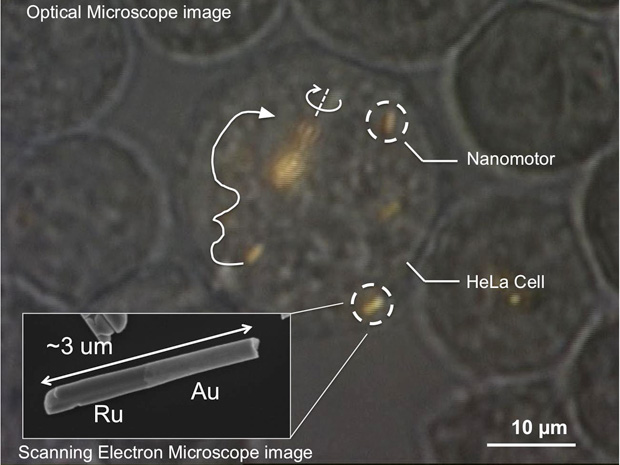For the first time in history, scientists have succeeded in remotely controlling nanoparticles armed with synthetic motors placed inside a human cell. The groundbreaking research was conducted at Penn State University using ultrasonic waves and magnetic forces to steer the particle’s movements ― a feat previously limited to the controlled environment of a test tube. The cell’s reaction to the foreign entity foreshadows future cancer treatment.
The research’s findings, published earlier this month in Angewandte Chemie International Edition, explores how the synthetic motor’s ability to move around inside the cell creates completely new angles for studying cellular biology, something previously impossible. “As these nanomotors move around and bump into structures inside the cells, the live cells show internal mechanical responses that no one has seen before,” exclaimed professor of material chemistry and physics and co-author of the study, Tom Mallouk.

Optical microscope image of a HeLa cell containing several gold-ruthenium nanomotors.
The cells used in the study were a human cervical cancer cell called HeLa that’s often used in research; after the nanoparticles made contact with the HeLa and were ingested, applying ultrasonic waves sprang their motors to life allowing them to move forward or spin. But, if the wave concentration was too little, then nothing happened. The challenge was establishing the proper balance.
Nanoparticles moving inside cancer cells quickly bumped in the cell’s specialized structures, known as organelles, and begin to tear them apart as a sort microscopic blender that homogenizes the cell’s content. Professor Tom Mallouk speculates that the nanometer’s ability to destroy cells from the inside has vast potential noninvasive cancer treatment, “Nanomotors could perform intracellular surgery and deliver drugs noninvasively to living tissues.”
A second outside influence applied in the form of magnetic force further enhances the ability to control the particles, allowing them to be steered. Mallouk and his fellow researchers further concluded that nanomotors can move independently of one another, offering even greater implications for the technique. “Autonomous motion might help nanomotors selectively destroy the cells that engulf them,” he suggests, “If you want these motors to seek out and destroy cancer cells, for example, it's better to have them move independently. You don't want a whole mass of them going in one direction.”
The first generation of nanomotors was actually created ten years prior, likewise by Penn State researchers. But an important differing factor between the past and present variants is that the former was chemically powered by toxic fuels and unable to move within bio-fluids. Mallouk and his colleagues hope that by harnessing the power of ultrasonic waves and magnetic forces, we are one step closer to establishing a diagnosis and treatment mechanism similar to the film Fantastic Voyage.
Via eurekalert.org
Advertisement
Learn more about Electronic Products Magazine





